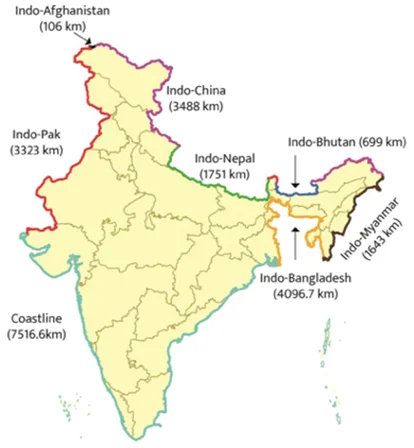Answer:
| Approach:
Introduction
- Introduce, acknowledging the complex security landscape along India’s borders with Myanmar, Bangladesh, and Pakistan including the Line of Control (LoC).
Body
- Discuss the specific threats and crimes along these borders.
- Highlight the role of various security forces.
Conclusion
- Conclude, re-emphasizing the challenges presented by the diverse border scenarios and the crucial role of security forces, diplomacy, and development initiatives in ensuring national security and stability.
|
Introduction:
With extensive borders along Myanmar, Bangladesh, and Pakistan, including the tense Line of Control (LoC), India experiences numerous security threats and crimes that cross these borders. Therefore, it’s vital to maintain high alertness and a solid security infrastructure to ensure national safety and peace.
Body:
Security threats and transborder crimes:
- Terrorism: Cross-border terrorism, predominantly from Pakistan along the LoC, is a major threat. For example, the 2008 Mumbai attacks and the 2019 Pulwama attack.
- Insurgency: Border regions, especially the India-Myanmar boundary, witness frequent insurgent activities led by groups such as NSCN-K and ULFA.
- Drug and Arms Trafficking: Illicit drug and arms trades, especially along the Golden Crescent (Afghanistan, Iran, Pakistan) and Golden Triangle (Myanmar, Laos, Thailand), impact the India-Pakistan and India-Myanmar borders respectively.
- Human Trafficking: This major issue along the India-Nepal and India-Bangladesh borders involves victims being forced into forced labour, sex trade, or domestic servitude.
- Illegal Immigration: Significant along the India-Bangladesh border, this causes socio-political issues in states like Assam and West Bengal, as revealed by the Assam NRC exercise.
- Cattle Smuggling: This is a significant problem along the India-Bangladesh border.
- Infiltration of Counterfeit Currency: This act, primarily via the India-Bangladesh and India-Nepal borders, aims to destabilize India’s economy.
- Maritime Security Threats: The vast coastline of India is susceptible to threats like the landing of terrorists (26/11 attack) and smuggling of goods and people.

Role of Security Forces and Technological Initiatives:
- Indian Army and Air Force: They guard the LoC and International Border (IB) with Pakistan, responding to ceasefire violations and conducting anti-terror operations, including surgical strikes.
- Border Security Force (BSF): The BSF, stationed along the India-Pakistan and India-Bangladesh borders, thwarts smuggling and infiltration attempts.
- Assam Rifles and Indo-Tibetan Border Police (ITBP): They guard the sensitive India-Myanmar and India-China borders respectively, combating insurgency and guarding against transgressions respectively.
- Central Reserve Police Force (CRPF) and National Security Guard (NSG): They play a significant role in counter-insurgency operations and counter-terrorism duties within the country.
- Indian Navy and Coast Guard: They safeguard India’s extensive maritime boundaries, ensuring security against threats from the sea.
- Technological Initiatives: Deployment of technologies like laser fences, thermal imagers, night vision devices, and radars enhances the capability of forces. The implementation of the Comprehensive Integrated Border Management System (CIBMS) aims to secure borders in difficult terrains.
Conclusion:
The multiplicity of threats across India’s vast and diverse borders necessitates a robust, multi-faceted response. Through a combination of vigilant security forces, bilateral dialogues, socio-economic initiatives in border regions, and technological advancements, India continues to confront and counter these manifold challenges to maintain national security and stability.
